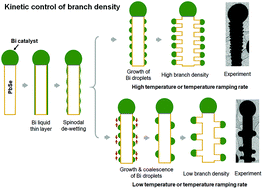Effects of catalyst droplets on wire growth and the resulting branched structures during VLS growth†
Abstract
The vapor–liquid–solid (VLS) method is vastly employed to grow hierarchical structures with unique properties. However, key questions remain, such as what controls the branched structures and what the roles of the catalyst droplet size are during the growth. Here, an in-depth understanding of the kinetics of the nucleation, growth, and subsequent coalescence processes of Bi liquid catalyst droplets is provided by direct observation of PbSe branched wire growth in an environmental transmission electron microscope. This brings a kinetic control of the branch density by varying the parameters, such as temperature. In addition, the dependence of the wire growth rate on the catalyst droplet size is revealed, i.e., the smaller the catalyst size the larger the wire growth rate, unlike the wire growth controlled by the Gibbs–Thomson effect, possibly due to different mass transport pathways and atomic surface diffusion. These results extend the fundamental understanding of the VLS growth mechanism of branched structures and benefit the structure design of hierarchical materials with tailored properties.



 Please wait while we load your content...
Please wait while we load your content...